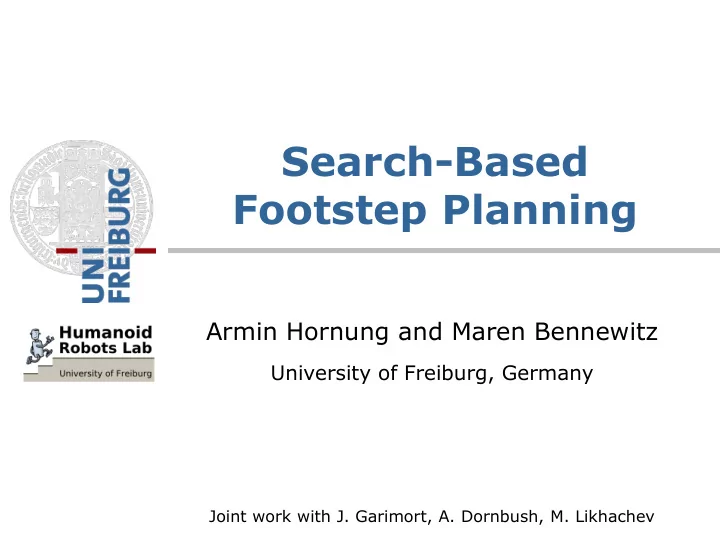

Search-Based Footstep Planning Armin Hornung and Maren Bennewitz University of Freiburg, Germany Joint work with J. Garimort, A. Dornbush, M. Likhachev
Motivation BHuman vs. Nimbro, RoboCup German Open 2010 Photo by J. Bösche, www.joergboesche.de
Path Planning for Humanoids Humanoids can avoid obstacles by stepping over or close to them However, planning whole-body motions has a high computational complexity [Hauser et al. ‘ 07, Kanoun ’10, …] Footstep planning given possible foot locations reduces the planning problem
Previous Approaches Compute collision-free 2D path first, then footsteps in a local area [Li et al. ‘03, Chestnutt & Kuffner ‘04] Problem: 2D planner cannot consider all capabilities of the robot goal start
Previous Approaches Footstep planning with A* [Kuffner ‘01, Chestnutt et al. ‘05, ‘ 07] Search space: (x,y, θ ) Discrete footstep set Optimal solution with A* Probabilistic Footstep Planning [e.g. Perrin et al. ‘ 11] Search space of footstep actions with RRT / PRM Fast planning results No guarantees on optimality or completeness
Footstep Planning State Footstep action Fixed set of footstep actions Successor state Transition costs reflect execution time: Euclidean distance constant step cost costs based on the distance to obstacles
Footstep Planning start
Footstep Planning start
Footstep Planning start
Footstep Planning estimated costs from s ’ to goal s ’ transition costs s path costs from start to s start
Footstep Planning ? s ’ planar obstacle s start
Heuristic Estimates the costs to the goal Critical for planner performance Usual choices: Euclidean distance 2D Dijkstra path h(s') goal expanded state state s'
Efficient Collision Checking Footprint is rectangular with arbitrary orientation Evaluating the distance between foot center and the closest obstacle may not yield correct or optimal results Recursively subdivide footstep shape = distance to the closest obstacle (precomputed map) [Sprunk et al. (ICRA ‘11)]
Search-Based Footstep Planning Concatenation of footstep actions builds a lattice in the global search space Only valid states after a collision check are added Goal state may not be exactly reached, but it is sufficient to reach a state close by (within the motion range) goal state current state
Search-Based Footstep Planning We can now apply heuristic search methods on the state lattice Search-based planning library: www.ros.org/wiki/sbpl Footstep planning implementation based on SBPL: www.ros.org/wiki/footstep_planner
Local Minima in the Search Space start goal expanded states A* will search for the optimal result Initially sub-optimal results are often sufficient for navigation Provable sub-optimality instead of randomness yields more efficient paths
Anytime Repairing A* (ARA*) Heuristic inflation by a factor w allows to efficiently deal with local minima: weighted A* (wA*) ARA* runs a series of wA* searches, iteratively lowering w as time allows Re-uses information from previous iterations [Likhachev et al. (NIPS 2004), Hornung et al. (Humanoids 2012)] Interactive Session III (Sa., 15:00)
ARA* with Euclidean Heuristic start goal w = 1 w = 10
ARA* with Dijkstra Heuristic w = 1 Performance depends on well- designed heuristic
Randomized A* (R*) Iteratively constructs a graph of sparsely placed randomized sub-goals (exploration) Plans between sub-goals with wA*, preferring easy-to-plan sequences Iteratively lowers w as time allows [Likhachev & Stentz (AAAI 2008), Hornung et al. (Humanoids 2012)] Interactive Session III (Sa., 15:00)
R* with Euclidean Heuristic start goal w = 1 w = 10
Planning in Dense Clutter Until First Solution A* R* ARA* ARA* Euclidean heur. Euclidean heur. Euclidean heur. Dijkstra heur. 11.9 sec. 0.4 sec. 2.7 sec. 0.7 sec.
Planning in Dense Clutter Until First Solution 12 random start and goal locations ARA* finds fast results only with the 2D Dijkstra heuristic, leading to longer paths due to its inadmissibility R* finds fast results even with the Euclidean heuristic
Planning with a Time Limit (5s) ARA* ARA* R* Euclidean heuristic Dijkstra heuristic Euclidean heuristic goal start fails, requires 43 sec. final w=1.4 final w=7 goal start clutter fails, requires 92 sec. final w=1.4 final w=8
Anytime Planning Results Performance of ARA* depends on well- designed heuristic Dijkstra heuristic may be inadmissible and can lead to wrong results R* with the Euclidean heuristic finds efficient plans in short time
Dynamic A* (D*) Allows for efficient re-planning in case of Changes in the environment Deviations from the initial path Re-uses state information from previous searches Planning backwards increases the efficiency in case of updated localization estimates Anytime version: AD* [Koenig & Likhachev (AAAI ‘00), Garimort (ICRA ’11)]
D* Plan Execution with a Nao
Efficient Replanning Plans may become invalid due to changes in the environment D* allows for efficient plan re-usage 2966 states, 1.05s 956 states, 0.53s
Different Footstep Sets for Nao and lead to significantly shorter paths has a significantly higher planning time Result: yields shortest paths with efficient planning times
Adaptive Level-of-Detail Planning Planning the whole path with footsteps may not always be desired in large open spaces Adaptive level-of-detail planning: Combine fast grid-based 2D planning in open spaces with footstep planning near obstacles Adaptive planning [Hornung & Bennewitz (ICRA ‘11)]
Adaptive Level-of-Detail Planning Allow transitions between all neighboring cells in free areas and between all sampled contour points across obstacle regions Traversal costs are estimated from a pre- planning stage or with a learned heuristic Every obstacle traversal triggers a footstep plan
Adaptive Planning Results 2D Planning Footstep Planning Adaptive Planning goal start <1 s planning time 29 s planning time <1s planning time, High path costs costs only 2% higher Fast planning times and efficient solutions with adaptive level-of-detail planning
Current Work: Planning in 3D
Summary Anytime search-based footstep planning with suboptimality bounds: ARA* and R* Replanning during navigation with AD* Heuristic influences planner behavior Adaptive level-of-detail planning to combine 2D with footstep planning Available open source in ROS: www.ros.org/wiki/footstep_planner Interactive Session III (Saturday, 15:00)
Thank you!
Recommend
More recommend